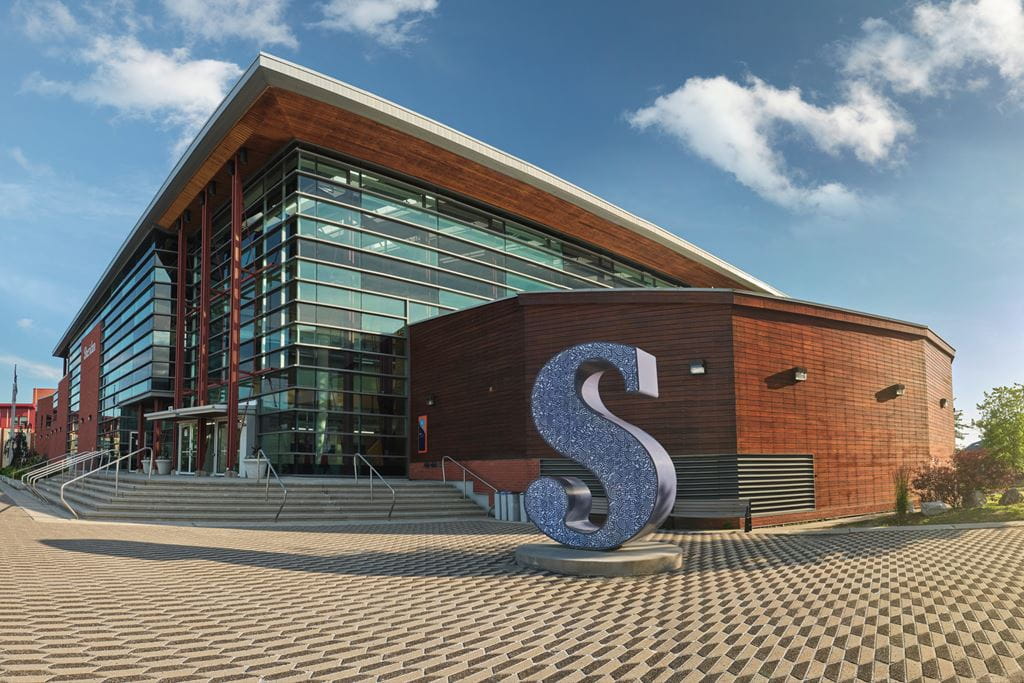
Sheridan makes significant strides towards energy and waste reduction goals

Efficient building design, district energy infrastructure, promoting green transportation, and facilitating meaningful engagement with community wellness projects are among the efforts that have made Sheridan an institutional model for how a 21st century organization embraces sustainability. Sheridan’s 2020 Sustainability Report released today, captures these successes and more.
While the institution’s Mission Zero goal, set in 2010/11, called for a 50% reduction in greenhouse gas (GHG) emissions by 2030, Sheridan has exceeded the target, achieving a 54% reduction more than a decade early. Other indicators of success include 35% less energy used per student from 2010/11 to 2018/19, a 54% (732 metric tonnes) reduction in landfill waste from our three campuses, and a 167% increase in recycling and organics when compared to data from before the introduction of Sheridan’s Zero Waste program in 2013/14.
“Our 2020 Sustainability Report represents a culmination of Sheridan’s interdepartmental efforts toward improving sustainability over the past decade,” says report author, Sheridan’s Office for Sustainability staff Dr. Anna Pautler. “Getting to this point has required investment in energy and waste infrastructure as well as changes to policies and practices. It also calls for a shift in campus culture through engagement from students, employees, internal and external vendors, and community members alike.”
In Sheridan’s Strategic Plan: Sheridan 2024: Galvanizing Education for a Complex World, sustainability is identified as one of its ‘empowering enablers’. Concretizing Sheridan’s commitment to sustainability through its institutional blueprint helps ensure that bold sustainability goals are established and efforts to attain them are actioned through a community-wide approach.
Sheridan’s buildings are a strong area of focus for establishing progressive sustainability standards. All new buildings on the college’s three campuses will be constructed to LEED Gold standards. One such new build, the B-Wing at the Hazel McCallion Campus in Mississauga, which opened in 2017, is 50% more energy efficient than the adjacent A-Wing constructed only six years prior. Features like in-floor radiant heat, a tight building envelope, and daylight harvesting have contributed to energy efficiency. A robust institutional Campus Master Plan will serve as a roadmap to guide Sheridan’s built environment over the next 30 years.
“Successfully balancing economic, social and environmental priorities requires institutional commitment and active participation from all members of our community,” says Herb Sinnock, Director of Sustainability at Sheridan. “Using a ‘living laboratory’ approach and embedding sustainability into our teaching and learning promotes it as an institutional priority and draws in our internal community to be part of action towards change.”
At the community level, Sinnock and his colleagues in Sheridan’s Facilities Management Department have been working with Brampton and Oakville to align the college’s environmental priorities with municipal plans. The adoption of Sheridan’s award-winning district energy project, which is a model for energy conservation and distribution, is being actively explored by local governments. It has the potential to expand beyond campus borders to local thermal energy networks, which will promote efficiencies in energy use for nearby businesses.
Students and employees are also regularly engaged in no-cost, recreational activities that promote sustainability. For example, in 2019, Sheridan launched its first Bike Hub at its Hazel McCallion Campus in Mississauga. Full-time students can rent bikes to get a feel for what it’s like to commute using a green mode of transportation or make use of tools for repairs. At Davis and Trafalgar Campuses, a Community Garden Project has brought together groups of employees and students who tend to their plots, yielding herbs and veggies.
Principled leadership in sustainability is also a significant driving force to building Sheridan’s reputation in the field. Dr. Janet Morrison, Sheridan’s President and Vice Chancellor, sits on the Colleges and Institutes Canada (CiCan) ImpAct Presidents’ Advisory Committee, which is tasked with actioning initiatives that align with the United Nation’s Sustainable Development Goals (SDGs). Sinnock lends his expertise to CiCan’s Sustainability Project Working Group. Recently, Sheridan appointed second-year Electromechanical Engineering Technician student Sahib Bhardwaj as its first SDG Youth Coordinator, responsible for educating and engaging his peers on the SDGs.
To advance Sheridan’s position in sustainability and climate change mitigation, through collaboration and engagement, Sheridan will be setting a new sustainability strategy, including updated targets, called Mission Zero 2024. They will be shared publicly by spring 2021. Also for 2021, Sheridan has been named by The Princeton Review to its list of 416 List Green Colleges. The list includes colleges who have exceptional sustainability-related policies, practices, and programs.
Media Contact
For media inquiries, contact Sheridan’s Communications and Public Relations team.
